The best task management software functions as a virtual to-do list and includes features that enable users to track a task’s deadline, status, assignment, and priority level. Project teams rely on task management software to identify, organize, and monitor small-scale, individual tasks and make decisions about collaborating across teams.
By evaluating multiple categories, our list of the best task management software includes providers with standout features and affordable plans for small business owners needing automated or collaborative project management tools.
- ClickUp: Best overall task management software
- monday.com: Best for tracking action items
- Nifty: Best for document management
- Trello: Best for Kanban-based task management
- Smartsheet: Best for automating workflows
- Todoist: Best simple tool for solopreneurs and small teams
Comparing the Best Task Management Software
Task Management Software | Monthly Starting Price | Key Features | Our Score out of 5 |
|---|---|---|---|
$10 |
| 4.85 | |
$12 |
| 4.76 | |
 | $12 |
| 4.43 |
$6 |
| 4.29 | |
$12 |
| 4.22 | |
$5 |
| 4.21 | |
ClickUp: Best Overall Task Management Software

Pros
- It allows unlimited tasks with custom types and statuses
- It has automation features with ClickUp Brain
- It allows multiple assignees and templates for complex projects
Cons
- Artificial intelligence features require an additional fee
- The free plan doesn’t support team collaboration
- File storage is limited on the free plan
Our Expert Opinion
I chose ClickUp to top our list of apps for task management because of its unlimited tasks and customizable project views. Project views allow users to visually shift their perspective on project tracking by viewing different aspects of a task. For example, calendar views make it easier to see due dates for each assignment, while board views offer more insights into your workflow management.
As the best all-in-one task management app, ClickUp provides dashboards to view tasks in a to-do list format, board, or calendar. Users can customize each board for more dynamic views, such as changing the columns, cards, and categories to suit their project goals and intent. As our best Gantt Chart software, ClickUp also offers free Gantt chart views and templates for more efficient project planning.
These customizable project views are paired with automation and artificial intelligence features, like ClickUp Brain. With Brain, you can access deep learning technology that answers your project questions instantly and automatically updates tasks and assignments. While AI can act as an automated project manager for small teams and solopreneurs, ClickUp’s AI features are add-ons with limited monthly actions.
In addition to customizability and automation, this task management software allows you to create multiple or single assignees for more equitable divisions of labor. However, the free plan doesn’t support many team collaboration features, so we recommend a platform like monday.com, which includes automation and AI for team collaboration and tracking action items.
Plans & Pricing | Free | Unlimited | Business |
|---|---|---|---|
Monthly | $0 | $10 | $19 |
Annually | $0 | $7 | $12 |
Although most of ClickUp’s task management features and 24/7 support are offered across plans, there are differences in access to customizability and project management. Beginning with the Free plan, you can access unlimited tasks and custom views, but many actions are limited. For example, Gantt charts only include up to 60 actions, and there is no support for team views.
The free plan includes only 100MB of data storage, while the paid plans have unlimited storage. Therefore, this plan is best for solopreneurs and small teams that don’t share many documents. Compared with the Free plan, the Unlimited plan unlocks many of the limitations of the first plan by providing more automation and customizable features.
However, this plan only provides access to some team collaboration features. It lacks public sharing and private documents, making it more difficult to track progress on projects with multiple teams or assignees. For large-scale project tracking and dynamic views, the Business plan provides project teams with the most task management features.
In addition to the essential plans, ClickUp offers an Enterprise plan with priority customer support features, like tailored onboarding and a dedicated account manager. To learn more about this plan, contact a sales representative for details on custom pricing and standout features.
- Task checklists: Simplify your to-do lists with drag-and-drop checklists or templates to organize tasks. The checklists also include a nesting feature to create sublists and the option to delegate tasks on your checklist with assignees.
- Custom task IDs: Each task you create includes a task ID for more efficient tracking. Business and Enterprise plan users can also customize these IDs to make it easier to identify tasks and organize project workflows.
- Mind maps: Get your ideas out of your head and into the world with Click-Up’s mind mapping software. Use this feature to create visual flow diagrams of projects with task assignments and notes.
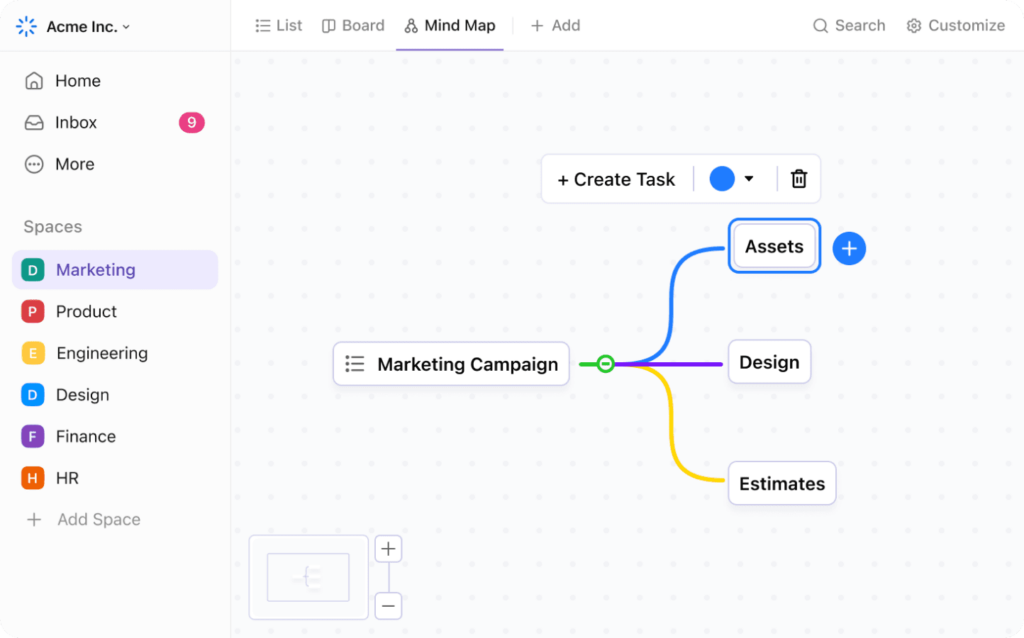
Visually plan your ideas with ClickUp’s mind-mapping software. (Source: ClickUp)
monday.com: Best for Tracking Action Items

Pros
- It allows unlimited dashboards and Kanban view
- It has color-coded to-do lists and task assignments
- It has 200-plus industry-specific templates
Cons
- Time tracking requires a Pro plan
- Mobile app capabilities are limited
- Task dependencies are limited to dates
Our Expert Opinion
monday.com is the best platform for tracking action items because of its customizable templates and colorful interface. You can choose from over 200 templates and design the visual elements of your board, including colors, columns, views, and groups. While monday offers standard project management views, like Kanban boards and Gantt chats, it also provides nontraditional tracking tools, like the Eisenhower Matrix or Action Plan template.
monday.com is also our best project management platform for small businesses because of its workflow automation capabilities. The platform is top-rated because it can handle any workflow across industries, such as marketing, sales, design, and software development. In addition to tracking projects, use it to manage customers, ad campaigns, and your sales pipeline.
Additionally, monday.com offers time-based tracking and task dependencies that can trigger an action item every time a task is completed or its status is changed. However, many of these task management features are only accessible on the Pro and Enterprise plans, which is not beneficial for solopreneurs or businesses with small teams.
While monday.com is great for tracking action items, I have found that its rich customization options can overwhelm individuals or teams with less complex project requirements (e.g., task monitoring and reminders). Consider a more straightforward alternative like Todoist if you need a platform for monitoring small, simple tasks.
Plans & Pricing (per seat) | Free | Basic | Standard | Pro |
|---|---|---|---|---|
Monthly | $0 | $12 | $14 | $24 |
Annually* | $0 | $9 | $12 | $19 |
*Pricing is for three seats with annual discounts.
monday.com offers essential plans and an enterprise service that fits the task management needs of multiple industries and small business owners. For an introduction to basic task management features like a dashboard, multiple column types, and templates for up to two seats, I recommend the free plan for solopreneurs managing personal projects.
In contrast, the Basic plan is more beneficial for small teams because it provides access to unlimited features, like unlimited boards, documents, and messages. The Standard plan is best for mid-sized businesses that require collaborative workspace management tools, like integration with meeting software, customizable fields, and access to additional project views.
Finally, the Pro plan is best for distributed teams working on complex projects. This plan includes access to more assignment-based task management tools, like time tracking and the dependency column, as well as 25,000 integration and automation actions to speed up managing team members and completing tasks.
Although most small business owners do not require enterprise-grade task management, the Enterprise plan provides the most capacious package, with 250,000 integration and automation actions, five years of activity logging, and 1,000GB of file storage. Feel free to contact a sales representative for information about custom pricing.
- Column types: A wide array of column types are available for storing data and organizing your board based on your project needs. Supported columns include people, status, date, numbers, timeline, rating, and world clock.
- Shareable forms: There are no-code form builders for generating personalized forms, which you can easily share with your employees or company website. You can also create follow-up questions with conditional logic.
- Customizable templates: Centralize your projects with premade and custom templates. These are useful for creating boards for specific industries, such as marketing, sales, human resources (HR), and software development.
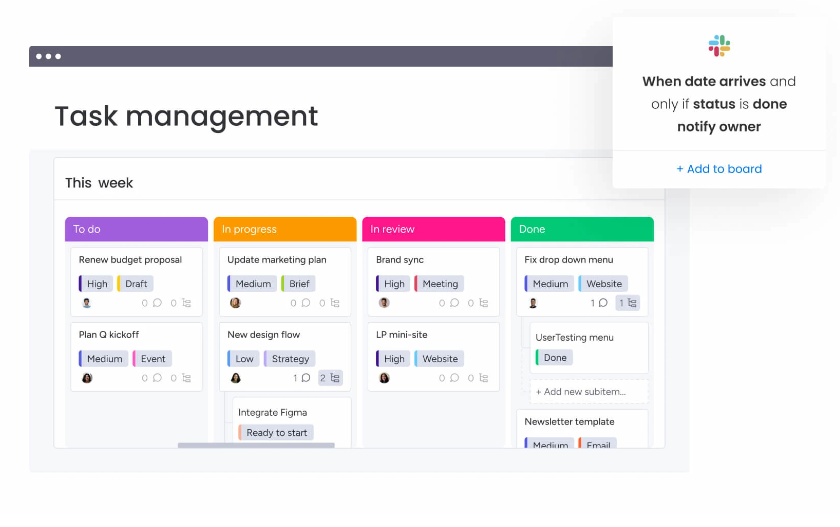
Differentiate between tasks and to-do lists with color-coded templates. (Source: monday.com)
Nifty: Best for Document Management

Pros
- It has time tracker for accountability and efficiency
- Task and milestone dependencies have recurring automations
- It has subtasks for multilevel project management
Cons
- App integrations are limited
- Workflow automations aren’t available on the Free or Personal plans
- It has poor dashboard customization
Our Expert Opinion
Nifty features a collaborative document hub where team members can consolidate documents and files with their projects. Specifically, Nifty’s document management capabilities make moving projects, teams, tasks, and files easier from other project management platforms like ClickUp, Trello, Wrike, or spreadsheet software.
With its Google Workspace integration, you can create Docs, Sheets, and presentations directly within Nifty. You can also launch a file from a project discussion so everyone involved can view, comment, and edit it. Then, centralize file management by uploading files from your computer, Dropbox, or Google Drive and sorting them by type.
While most task management software only provides access to features like time trackers, recurring tasks, or milestone dependencies in paid plans, Nifty offers robust task management features on the free plan, making it an excellent choice for budget-conscious business owners. However, if you need to automate tasks, you must upgrade to one of the higher-tier plans.
Compared with other providers on the list, Nifty integrates with only a handful of third-party applications, including Slack, Zoom, and Microsoft Suite. These limited integrations may not complement companies needing a task management solution that readily integrates with their app stack.
If you’re looking for a Nifty alternative with extensive app connectivity, try monday.com. This provider works with over 200 business solutions to enable teams to centralize data in one place.
Plans & Pricing (per member) | Free | Personal | Pro | Business |
|---|---|---|---|---|
Monthly | $0 | $12 | $16 | $25 |
Annually | $0 | $7 | $10 | $16 |
Nifty provides scalable task management tools across several plans, from free to enterprise-grade project management. Although the Free plan only provides 100MB of storage and two active projects, it does give you access to enough tasks, team chat, portfolios, docs, milestones, and files for successful task management.
The Personal plan provides a significant bump in file storage and features, with 100GB of storage for 40 projects, including time and budget tracking, reporting, and custom fields. Therefore, this is the best plan for small businesses managing projects for a client or customer.
The Pro plan also introduces file proofing and workflow automation for 100 projects, making it ideal for managing routine or recurring tasks. Similarly, the Business plan is excellent for workload management and team collaboration because of its unlimited storage, projects, and custom roles.
Contact sales to learn more about custom pricing for the Enterprise plan, which provides the most customer support features, such as a dedicated account manager and priority support. I also recommend the 14-day free trial to preview Nifty’s task management features.
- Proofing: Add comments or feedback directly on files or videos and transform comments into a task to track real-time progress. This speeds up the approval process for action-oriented proofing.
- Recurring tasks: Uses custom criteria to automate task creation instead of creating tasks manually. There are three ways for a task to repeat: date, status, and completion.
- Swimlane view: Nifty offers hybrid project views that align your milestones with specific tasks. Like a Kanban board, the swimlane view segments a project into color-coded columns to organize large teams visually.
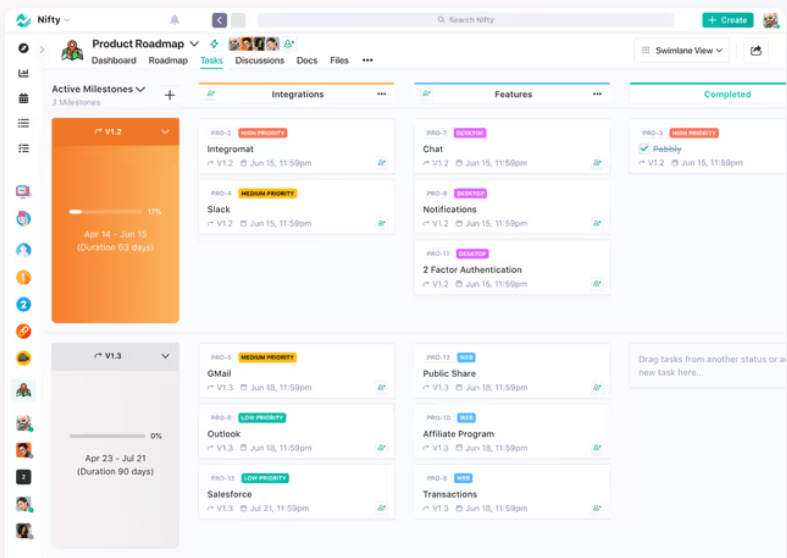
Combine milestones and tasks with Nifty’s swimlane view. (Source: Nifty)
Trello: Best for Kanban-based Task Management

Pros
- It has robust project visualization options with customizable cards
- It has no code automation platform
- It allows 200-plus third-party integrations with Trello Power-Ups
Cons
- Workspace management tools for Free and Standard plans are limited
- It’s not suitable for complex projects
- Project reporting requires an integration
Our Expert Opinion
Known for its Kanban software and customizable boards, Trello is the best task management software for individuals and small teams needing a quick and straightforward view of their workflows. The free plan includes many advanced features, such as built-in automations, custom templates, and unlimited access to over 200 third-party apps, making it a cost-effective option for solopreneurs and small business owners.
Additionally, an interactive board lets you add lists for tracking project stages and organizing information cards. Customize your board by assigning members, leaving comments, and adding due dates. The Kanban-based templates are also available for different industries and project types, such as agile project management methods.
At the same time, Trello may be less suited for larger project teams with more dynamic and complex tasks. If you’re looking for a more versatile solution with built-in analytics and reporting, you might want to give monday.com a try. In addition to Kanban boards, this provider supports more dynamic project views, including Gantt, timeline, calendar, and card views.
Plans & Pricing (per user) | Free | Standard | Premium | Enterprise* |
|---|---|---|---|---|
Monthly | $0 | $6 | $12.50 | $Annual billing only |
Annually | $0 | $5 | $10 | $17.50 |
*Price reflects plans with up to 250 users; volume discounts are available.
Trello is one of many task management apps Atlassian provides for organizing processes and tracking projects. Each tier of the four Trello plans offers specific features that work best for businesses of different sizes, project types, and task complexity. However, it only includes monthly plans, without the annual discount offered by most software providers.
For solopreneurs and small teams with simple projects, the Free plan includes unlimited cards for up to 10 boards with built-in automation, templates, and unlimited storage. This plan also offers 250 workspace command runs, unlimited activity logs, and app integrations, which is a more generous package than many of the free plans on this list.
Small teams that need collaborative tools will benefit from the Standard plan, which includes unlimited boards, checklists, custom fields, and 1,000 Workspace command runs. In contrast, the Premium plan suits teams with more complex projects and timelines by offering dashboard and workspace views with customizable templates and advanced security features. You can also sign up for a 14-day free trial to preview the Premium plan.
While many software providers include custom pricing for Enterprise plans, Trello provides transparent pricing for its enterprise-grade plan. This plan offers unlimited workspaces and organization-visible boards, with volume discounts for subscriptions with over 250 members.
- Advanced checklists: Organize tasks into a single, easy-to-access list. Add a checklist to a card, list all the tasks as items, and assign a due date and team member.
- Butler automation: Set up automation, commands, and rules on your Trello board to reduce manual and repetitive work. For example, if a Trello card is moved to the “Done” list, all items, including the checklist, due date, and members, will be crossed off.
- Card templates: A card is the most detailed unit of a Trello board for representing tasks and ideas. It can hold a wide variety of information, like reminders or a to-do list. Therefore, card templates can be used to copy tasks and assignments quickly.
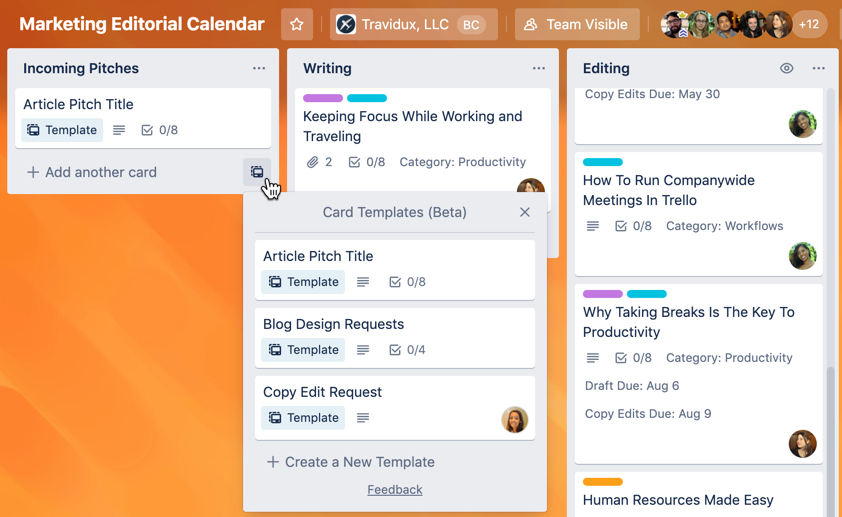
Use Trello card templates to repeat tasks and customize workflows. (Source: Trello)
Smartsheet: Best for Automating Workflows

Pros
- It has unlimited dashboards, reports, and forms across plans
- It allows automatic task assignments for more efficient people management
- It can integrate with Slack and Microsoft Teams for task reminders
Cons
- It has a steep learning curve for users less familiar with spreadsheet software
- It doesn’t offer a free plan
- Most priority support features are add-ons
Our Expert Opinion
Smartsheet is well-known as a platform that enhances task management with automated workflows. Each plan includes a set amount of monthly automations, allowing users to assign tasks to individuals and send alerts or reminders for due dates and task completion. Additionally, these automations can be integrated with communication platforms like Slack and Microsoft Teams, enabling instant updates on any actions.
The platform also leverages artificial intelligence (AI) to develop automated processes for more productive and goal-oriented teams. These tools can analyze data, generate text summaries, and provide immediate answers with AI assistants. However, AI is only available for Enterprise plans.
Although Smartsheet works well for teams familiar with spreadsheets, the primary issue in user reviews is its steeper learning curve than other software. Without a free plan, users might sign up for the Pro plan only to find out that the software doesn’t work well for them. So, if you are interested in using Smartsheet, I recommend the Business plan, which includes a 30-day free trial to try out most of the task management features before committing to the contract.
Additionally, Smartsheet is an enterprise-grade workforce management software, so it might not address the needs of small business owners looking for simple and affordable task management. Therefore, you should check out ClickUp for free project management software with scalable plans and an intuitive interface.
Plans & Pricing(per member) | Pro | Business |
|---|---|---|
Monthly | $12 | $24 |
Annually | $9 | $19 |
One of the primary differences between Smartsheet and the other providers on this list is the pricing structure. Smartsheet is the only provider that doesn’t offer a free plan, and there are only two essential plans: Pro and Business. The Pro plan provides project tracking and tasking management for one to 10 members a month, with unlimited sheets, forms, reports, and up to 250 monthly automations.
In contrast, the Business plan is best for businesses managing multiple teams because it includes unlimited automations with workload tracking and admin capabilities that simplify people management. This plan also offers 1TB of data storage, which is excellent for teams that share documents and media content.
In addition to the essential plans, Smartsheet offers two plans with custom pricing, the Enterprise and Advanced Work Management plans. The Enterprise plan includes Smartsheet’s AI features, such as AI formulas and charts, and a dedicated workspace manager with access to the WorkApps platform and Work Insights.
The Advanced Work Management plan provides everything you need to manage large teams or an extensive portfolio of clients, such as integrations with workspace management tools like Jira and Salesforce. This plan also provides dynamic views and apps for advanced data analytics. Contact a sales associate to learn more about these customizable plans.
- Forms: A dedicated form builder lets you create rules to collect data and assign tasks. These forms can also be customized with company branding and color schemes.
- Workload tracking: View each team member’s capacity and prioritize tasks based on workload and work allocation. You can also reallocate tasks to avoid uneven workloads.
- File library: Create a central space for storing your files, making them easier to search and find for collaborative projects and tasks. Simply upload your files to the library to access them in your workspace.
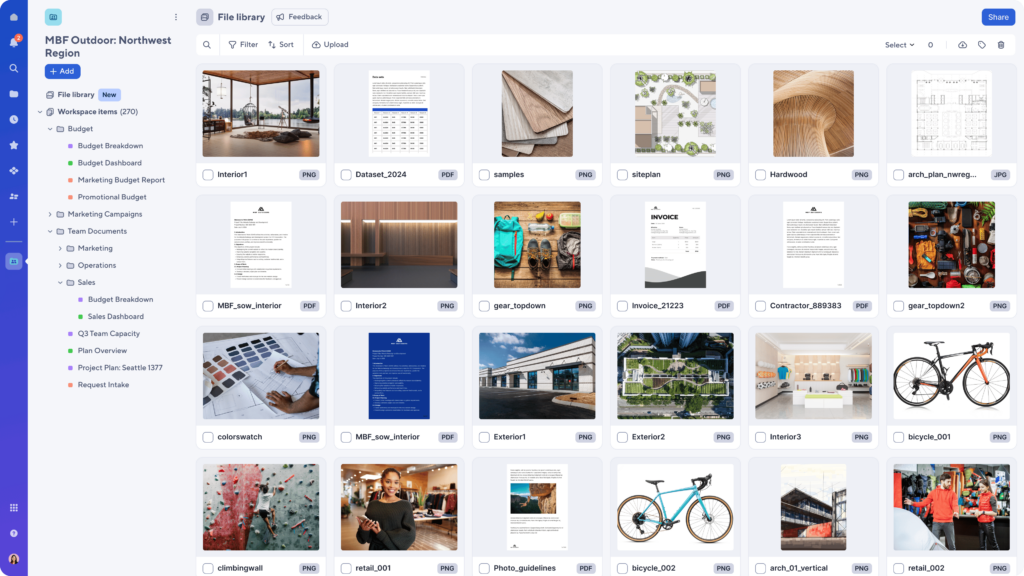
Streamline workflows and tasks with the accessible file library. (Source: Smartsheet)
Todoist: Best Simple Tool for Solopreneurs & Small Teams

Pros
- It has productivity visualizations with task-completion graphics
- It allows 90-plus integrations with applications and communication tools
- Recurring due dates
Cons
- Limited personalization features
- Tools for collaborative teams are only available on the Business plan
- Does not offer an enterprise-grade plan
Our Expert Opinion
Todoist is the best task management software for solopreneurs and small teams because of its simple tools for managing less intensive tasks. As the name suggests, it works as a to-do list app enhanced with tools like task delegation, boards, recurring due dates, and calendar feeds. You can also access all your to-do lists alongside your work projects, errands, weekly plans, and upcoming events in a user-friendly interface.
At the same time, Todoist’s simplicity does not mean it lacks advanced features. In addition to simple task management tools, the higher tier plans include access to AI, like an AI assistant to help with tasks and filters, productivity visualizations with colorful graphs, and integrations with other workspace tools.
However, Todoist’s list-based approach may not work well for teams that need more complex project management software for customizable workflows, advanced security features, and task automation. In this case, I recommend Smartsheet, which offers enterprise-grade plans beyond a basic to-do list and includes analytics, automation, and workspace management tools.
Plans & Pricing (per user) | Beginner | Pro | Business |
|---|---|---|---|
Monthly | $0 | $5 | $8 |
Annually | $0 | $4 | $6 |
Todoist is the only provider that doesn’t offer enterprise-grade plans, unlike other task management software on this list. Instead, you can choose from three essential plans that reflect some of the most affordable prices in the industry and provide simple task management for personal projects and goals.
For example, the Beginner plan is a free plan that includes five active projects, 5MB file uploads, and five guests. However, it lacks team collaboration and artificial intelligence features and only offers limited automated features, like recurring due dates. In contrast, the Pro plan includes an AI assistant and expands on advanced features like custom reminders and an unlimited activity history.
The highest-tier plan is the Business plan, which provides various team collaboration tools for more complex projects, such as shared project templates, up to 250 team members per project team, role assignments, and 100MB file uploads. Todoist also regularly updates its software and plans with new features and task management tools, so you should visit the website to stay updated as each plan expands.
- Subtasks: Break tasks into smaller parts and divide work among multiple team members. They are embedded within a parent task with the same set of fields, making it easier to organize assignments.
- Activity history: This provides a complete snapshot of your account activity and other collaborators, organized by date. You can filter tasks by completion, updates, modifications, and deleted tasks.
- Task descriptions: To facilitate project start-up and completion, you can add details to each task, such as brief descriptions, documents, due dates, and instructions.

Use descriptions to create clear instructions for each task. (Source: Todoist)
How We Evaluated the Best Task Management Software
I assessed a variety of task management software based on popularity, industry sentiments, and functionality ratings among users. I used a six-category rubric to evaluate and compare the providers. After computing the final scores, I selected the top six based on which ranked the highest.
Learn more about the evaluation criteria for the best task management software by clicking on the tabs below:
20% of Overall Score
I examined the best task management software subscription plans and awarded points to those charging less than $15 for the base plan. Then, I explored their value for the money, giving more weight to those offering free-forever plans, as well as annual and volume discounts.
25% of Overall Score
I compiled a list of capabilities typically found in a task management solution, including time tracking, assigned roles, and reminders. I also checked if all plans support two-factor authentication to ensure account security and provide a mobile application for ease of use.
20% of Overall Score
Many providers offer industry-specific features that accommodate unique project management needs. These include features like customizable dashboards, documentation, and diverse project views. I also compared the number of third-party integrations and automation and artificial intelligence tools made available to users.
10% of Overall Score
I assessed the usability of each task management platform by investigating product demos, user manuals, and customer reviews from reliable websites. I also reviewed the feedback of recent users and checked for the technical skills required for onboarding and operating the project management tools.
10% of Overall Score
I investigated the types of customer service channels each task manager software offers, such as phone, live chat, email, and help desk. Platforms with 24/7 coverage were awarded higher points.
15% of Overall Score
After assessing each rubric category, I reviewed the performance of each task management system by comparing its features to the value for money and ease of use. Then, I evaluated user reviews from third-party consumer websites to determine any standout issues or benefits for small business owners.
What Should You Look for in a Task Management Tool?
The right task management software for your business depends on factors concerning your team’s project management strategy. First, identify your existing project challenges (e.g., missed deadlines and uneven workload). Next, create a list of criteria based on your budget, team size, file storage capacity, and must-have features. From there, list the top options that fit your unique requirements.
For example, some of the core features to look for include time tracking, calendars, custom dashboards, resource management, and automation tools. The best task management software also supports a variety of project views, from Gantt charts to list-based to Kanban style. Depending on your business, you should also look for tools that offer additional security features, like multifactor authentication.
Frequently Asked Questions (FAQs)
Task management software is available at a range of prices, with monthly plans starting as low as $5 per user and a free plan available for small teams on a budget. Some providers also offer enterprise plans with customizable pricing that can go well over $15 a month per member or user.
We picked ClickUp as the best task management software because it supports unlimited tasks, diverse project views, and customizable scheduling and assignments. For small businesses, ClickUp is an excellent choice for tracking personal and collective projects. It delivers many workflow automation tools, team collaboration features, and free and paid plans for various industries and business needs.
Tracking action items is crucial for collaboration, as it helps provide insight into the next steps after a meeting and allows for progress tracking throughout a project. We recommend using monday.com to track action items because it offers dynamic project views that streamline workflows and manage team members. Specifically, monday.com features action-item templates and columns that enhance visibility at each project stage.
Yes, Google Tasks is one of many apps for task management that can be used to make lists and keep track of your daily to-do list. As part of the Google Workspace suite of tools, Google Tasks integrates with Google Calendar and Gmail to provide more visibility to your scheduled tasks and assignments.
Bottom Line
Task management software comes in many forms and often helps streamline the complex process of managing projects and people. In the era of AI, the best task management apps feature automated assignments and customizable dashboards for simplified project organization and calendar scheduling.
We chose ClickUp as the best task management software for keeping lists and managing to-do items. It has valuable features for solopreneurs and larger teams, accommodating various task management needs with interactive tools for visualizing and prioritizing tasks. To explore what ClickUp offers, check out their free forever workspace plan.